LG Electronics USA P655H Multi-Band GSM/WCDMA/LTE Phone with WLAN and Bluetooth User Manual LG P655h UG EN JB 130718 indd
LG Electronics MobileComm USA, Inc. Multi-Band GSM/WCDMA/LTE Phone with WLAN and Bluetooth LG P655h UG EN JB 130718 indd
Users Manual

ENGLISH
www.lg.comMFL00000000 (1.0)
User Guide
LG-P655h

2CTVUVCVGOGPV
&KDQJHRU0RGLILFDWLRQVWKDWDUHQRWH[SUHVVO\DSSURYHGE\WKHPDQXIDFWXUHUFRXOGYRLG
WKHXVHUVDXWKRULW\WRRSHUDWHWKHHTXLSPHQW
2CTVUVCVGOGPV
7KLVHTXLSPHQWKDVEHHQWHVWHGDQGIRXQGWRFRPSO\ZLWKWKHOLPLWVIRUDFODVV%GLJLWDO
GHYLFHSXUVXDQWWR3DUWRIWKH)&&5XOHV7KHVHOLPLWVDUHGHVLJQHGWRSURYLGH
UHDVRQDEOHSURWHFWLRQDJDLQVWKDUPIXOLQWHUIHUHQFHLQDUHVLGHQWLDOLQVWDOODWLRQ7KLV
HTXLSPHQWJHQHUDWHVXVHVDQGFDQUDGLDWHUDGLRIUHTXHQF\HQHUJ\DQGLIQRWLQVWDOOHGDQG
XVHGLQDFFRUGDQFHZLWKWKHLQVWUXFWLRQVPD\FDXVHKDUPIXOLQWHUIHUHQFHWRUDGLR
FRPPXQLFDWLRQV+RZHYHUWKHUHLVQRJXDUDQWHHWKDWLQWHUIHUHQFHZLOOQRWRFFXULQD
SDUWLFXODULQVWDOODWLRQ,IWKLVHTXLSPHQWGRHVFDXVHKDUPIXOLQWHUIHUHQFHRUWHOHYLVLRQ
UHFHSWLRQZKLFKFDQEHGHWHUPLQHGE\WXUQLQJWKHHTXLSPHQWRIIDQGRQWKHXVHULV
HQFRXUDJHGWRWU\WRFRUUHFWWKHLQWHUIHUHQFHE\RQHRUPRUHRIWKHIROORZLQJPHDVXUHV
5HRULHQWRUUHORFDWHWKHUHFHLYLQJDQWHQQD
,QFUHDVHWKHVHSDUDWLRQEHWZHHQWKH HTXLSPHQWDQGUHFHLYHU
&RQQHFWWKHHTXLSPHQWLQWRDQRXWOHWRQDFLUFXLWGLIIHUHQWIURPWKDWWRZKLFKWKH
UHFHLYHULVFRQQHFWHG
&RQVXOWWKHGHDOHURUDQH[SHULHQFHGUDGLR79WHFKQLFLDQIRUKHOS
Part .19 statement
7KLVGHYLFHFRPSOiesZLWKSDUWRI)&&UXOHV.2SHUDWLRQLVVXEMHFWWRWKHIROORZLQJ
WZRFRQGLWLRQV7KLVGHYLFHPD\QRWFDXVHKDUPIXOLQWHUIHUHQFHDQG
WKLVGHYLFHPXVWDFFHSWDQ\LQWHUIHUHQFHUHFHLYHGLQFOXGLQJ
LQWHUIHUHQFHWKDWPD\FDXVHXQGHVLUHGRSHUDWLRQ
$QF[YQTP1RGTCVKQP
7KLVGHYLFHwasWHVWHGIRUtypical ERG\ZRUQRSHUDWLRQVZLWKWKH back of the phone kept
FP LQFKHVEHWZHHQWKHXVHUĜVERG\DQGWKHback of the SKRQH
7RFRPSO\ZLWK)&&5)H[SRVXUH UHTXLUHPHQWVDPLQLPXPVHSDUDWLRQGLVWDQFHRIFP
LQFKHVPXVWEHPDLQWDLQHG betweenWKHXVHUVERG\ and the back of the phone
7KLUGSDUW\EHOWFOLSVKROVWHUVDQGVLPLODUDFFHVVRULHVFRQWDLQLQJ PHWDOOLFFRPSRQHQWVPD\
QRWEHXVHG%RG\ZRUQDFFHVVRULHVWKDWFDQQRWPDLQWDLQFPLQFKHVVHSDUDWLRQ
GLVWDQFHEHWZHHQWKHXVHUVERG\DQGWKHback of SKRQHDQGKDYHQRW EHHQWHVWHGIRU
W\SLFDOERG\ZRUQRSHUDWLRQVPD\QRWFRPSO\ZLWK)&&5)H[SRVXUHOLPLWV DQGVKRXOGEHDYRLGHG
7KLV GHYLFHLVQRWLQWHQGHGIRUVDOHLQWKH86$

LG-P655h
LG-P655h User Guide
English
• Screen displays and illustrations may differ
from those you see on actual phone.
• Some of the contents of this guide may
not apply to your phone, depending on
the software and your service provider. All
information in this document is subject to
change without notice.
• This handset is not suitable for people who
have a visual impairment due to the touch
screen keyboard.
• Copyright ©2013 LG Electronics, Inc. All rights
reserved. LG and the LG logo are registered
trademarks of LG Group and its related
entities. All other trademarks are the property
of their respective owners.
• Google™, Google Maps™, Gmail™, YouTube™,
Google Talk™ and Google Play™ are
trademarks of Google, Inc.

2
Table of contents
Important notice ................................5
Getting to know your phone ........... 12
Phone overview ......................................12
Installing the Micro SIM card and
battery ...................................................... 14
Charging your phone ...........................15
Inserting a microSD card ....................16
Removing the microSD card.............. 17
Formatting the microSD card ............18
Locking and unlocking the screen ...18
Your Home screen ............................ 19
Touch Screen tips ................................. 19
Home screen .........................................20
Customizing the Home screen .....20
Returning to recently-used
applications.............................................21
Notifi cations ............................................ 21
Swipe down for notifi cations &
settings ................................................ 22
Quick Settings ...................................22
Indicator icons on the Status Bar .22
On-screen keyboard ............................24
Entering accented letters................24
Google account setup ..................... 25
Connecting to Networks
and Devices ...................................... 26
Wi-Fi ........................................................26
Connecting to Wi-Fi networks.......26
Turning Wi-Fi on and connecting to
a Wi-Fi network .................................26
Bluetooth ................................................ 26
USB T
ethering
.......................................28
Smartphone Mobile Hotspots ..........29
Enabling Wi-Fi Direct to share
through SmartShare ...........................29
SmartShare ............................................30
Calls .................................................. 33
Making a call .........................................33
Calling your contacts ...........................33
Answering and rejecting a call .........33
Adjusting the in-call volume .............34
Making a second call ..........................34
Ending a Call .........................................34
Ending a Call from the Status Bar...35
Viewing your call logs ..........................35
Call settings ...........................................36
Contacts ............................................37
Searching for a contact ...................... 37
Adding a new contact ......................... 37
Favorite Contacts.................................. 37
Creating a group ..................................38
Messaging ........................................ 39
Conversation view ................................39
Sending a message ............................39
Using smilies .........................................40
Changing your message settings ....40
Email .................................................. 41
Managing an email account...............41
Working with account folders............. 41
Composing and sending email ........42
Camera ............................................. 43
Getting to know the viewfi nder .........43
Using the advanced settings ............44

3
Taking a quick photo ..........................45
Once you've taken a photo ................45
Viewing your saved photos ................ 47
Video camera ................................... 48
Getting to know the viewfi nder .........48
Using the advanced settings ............49
Recording a quick video .....................49
After recording a video .......................50
Watching your saved videos ..............50
Adjusting the volume when viewing a
video ........................................................50
LG Unique Functions ....................... 51
QuickMemo ............................................51
Using the QuickMemo options .....52
Viewing the saved QuickMemo ....52
Live Zooming ........................................53
QSlide .....................................................54
QuickTranslator .....................................54
VuTalk ...................................................... 56
Registering VuTalk ............................56
Using VuTalk ...................................... 57
Multimedia ....................................... 59
Gallery .....................................................59
Viewing pictures ................................59
Zooming in and out .........................59
Playing videos ....................................59
Viewing photo and video options .60
Deleting images and videos ..........60
Setting as wallpaper .........................60
Videos .....................................................60
Playing a video ..................................60
Video Wiz ................................................61
Music .......................................................63
Add music fi les to your phone ......63
Transfer music using Media sync
(MTP) ...................................................63
Playing a song ...................................63
Utilities ............................................. 66
Setting your alarm ...............................66
Using your calculator...........................66
Adding an event to your calendar ...66
Lookout Security .................................. 67
T-Mobile TV ...........................................68
T-Mobile Name ID ...............................68
File manager .........................................68
Application Manager ........................... 69
Visual Voicemail .................................... 70
Voice Recorder ...................................... 70
Recording a sound or voice ........... 70
Sending the voice recording.......... 70
Task Manager ......................................... 71
Polaris Viewer 4 ..................................... 71
FileShare .................................................. 71
Backup .................................................... 72
About backing up and restoring
smartphone data .............................. 72
Backup your smart phone data .... 73
Scheduling automatic backups .... 73
Restoring smartphone data ........... 73
Google+ .................................................. 74
Voice Search .......................................... 74
Downloads .............................................. 75
The Web ............................................76
Browser ................................................... 76
Using the Web toolbar .................... 76
Viewing webpages
............................ 76

4
Table of contents
Opening a page ................................ 76
Searching the web by voice ........... 77
Bookmarks .......................................... 77
History .................................................. 77
Using QSlide ...................................... 77
Chrome ................................................... 77
Viewing webpages ............................ 78
Opening a page
................................ 78
Searching the web by voice ........... 78
Syncing with other devices ............. 78
Settings ............................................ 79
Access the Settings menu ................ 79
WIRELESS & NETWORKS ................ 79
DEVICE ...................................................82
PERSONAL ...........................................84
SYSTEM ..................................................86
LG On-Screen Phone ...................... 90
LG SOFTWARE ....................................90
On-Screen Phone icons .....................90
On-Screen Phone features ................90
How to install On-Screen Phone on
your PC .................................................... 91
How to connect your mobile phone to
your PC .................................................... 91
To check the phone-to-PC
connection .............................................92
To disconnect your phone from your
PC ............................................................92
Phone software update .................. 93
Phone software update ...................... 93
LG Mobile Phone Software update via
Over-the-Air (OTA) .............................. 93
About this user guide ..................... 95
Accessories ...................................... 96
Technical data ...................................97
Troubleshooting ............................... 98
For Your Safety ...............................102
Safety instructions .........................108

5
Important notice
Before you start using the phone, please read this!
Please check to see if any problems you have encountered with your phone
are described in this section before taking the phone in for service or calling a
service representative.
1. Phone Memory
In order to make more memory available, you will have to manage your
applications and delete some data, such as applications or messages.
Managing applications
1 From the Home screen, tap Apps > Settings > Apps.
2 When the list of applications appears, scroll and tap the application you
want to disable.
3 Tap Uninstall and then tap OK to confi rm that you want to uninstall the
desired application.
To stop applications
1 From the Home screen, tap Apps > Settings > Apps and select the
RUNNING tab.
2 Scroll to the desired application and tap Stop to stop it.
Moving applications
To manage the internal storage efficiently, you can move applications from
phone to the microSD card.
1 Touch > > Apps.
2 Tap the downloaded application and then tap Move to SD card.

6
2. Optimizing Battery Life
You can extend your battery’s life between charges by turning off features that
you don’t need to run constantly in the background. You can also monitor how
applications and system resources consume battery power.
To extend the life of your battery
• Turn off radio communications that you aren’t using, such as Wi-Fi, Bluetooth,
or GPS.
• Lower screen brightness and set a shorter screen timeout.
• Turn off automatic syncing for Gmail™, Calendar, Contacts, and other
applications.
• Some applications you have downloaded may cause your battery power to be
reduced.
• While using downloaded applications, check the battery charged level.
To view the battery charge level
1 From the Home screen, tap Apps > Settings > About phone >
Battery.
2 The battery status (charging or discharging) and level are displayed on the
top menu of the screen.
To monitor and control what uses the battery
1 From the Home screen, tap Apps > Settings > About phone >
Battery > Battery use.
2 The bottom of the screen displays battery usage time and also lists applications
or services using battery power from greatest amount to least.
3. Installing an Open Source Operating System
Installing an open source operating system on your phone and not using the
operating system provided by the manufacturer can cause your phone to
malfunction.
Important notice

7
Warning!
• If you install and use an OS other than the one provided by the manufacturer, your
phone is no longer covered by the warranty.
• To protect your phone and personal data, download applications only from trusted
sources, such as Play Store. If some applications are not properly installed on your
phone, your phone may not work properly- or serious errors may occur. You will need
to uninstall those applications and all of its data and settings from the phone.
4. Using an unlock pattern
Set a screen lock to secure your phone from unauthorized use. To set the
screen lock, follow the process below.
From the Home screen, tap Apps > Lock screen > Select screen lock and
select from Swipe, Face Unlock, Pattern, PIN or Password.
NOTE: In case that you have trouble with Face Unlock, you can unlock the
screen with a pattern and/or PIN as a backup.
Warning! Take precautions when using an Unlock Pattern, PIN, or Password. It
is very important that you remember the screen unlock information you set. You
are allowed 5 attempts to enter your screen unlock information. If you used up
all 5 opportunities, you will have to wait 30 seconds to attempt unlocking the
phone again.
When you can’t recall your Unlock Pattern, PIN, or Password:
If you logged into a Google account on the phone and failed to use the correct
pattern 5 times, tap Forgot pattern? You will be required to sign in with your
Google account and prompted to create a new unlock pattern.
If you have set a backup PIN, you can unlock the screen by entering the
backup PIN.
If you haven’t created a Google account on the phone or you forgot your PIN or
Password, you need to perform a hard reset.

8
5. Using Hard Reset (Factory Reset)
If your phone needs to be restored to its original condition, use a Hard Reset to
initialize your phone.
Warning! If you perform a Hard Reset, all user applications and user data will be
deleted. Please remember to back up any important data before performing a
Hard Reset.
1 Turn the phone off.
2 Press and hold the Power/Lock Key + Volume Down Key .
3 LG Logo appears on the screen. And after a few seconds, FACTORY
HARD RESET screen will appear, now release all keys.
4 The phone will allow you to select the factory reset function in the Android
system recovery utility by pressing Power/Lock Key .
5 Press the Power/Lock Key again to confi rm factory reset and your phone
will be restored to its factory settings. To cancel, press any other key.
6. Using Safe Mode
To recover your phone when malfunctioning.
1 Turn off your phone and reboot. When you see the T-Mobile animation
press and hold the Volume Down Key . Your main screen will then be
displayed with the words “Safe mode” in the lower left corner.
2 From the Home screen, tap the Menu Key and tap System settings >
Apps.
3 Tap one of the available tabs at the top of the screen and select the application
you wish to uninstall.
4 Tap Uninstall and OK to confi rm.
5 After uninstalling the application, turn off and reboot your phone.
Important notice

9
7. Using a microSD Card
Pictures, Music and Video files, can be saved to external memory. Before
saving these files to external memory, you need to insert a microSD card. If you
have not inserted a microSD card, your items will be saved to internal memory.
Warning! Do not remove the microSD card without unmounting it first.
Otherwise, it may damage the microSD card as well as your phone, and the
data stored on the microSD card may be corrupted. To unmount the microSD
card, from the Home screen, tap the Menu Key and tap System settings >
Storage > Unmount SD card > OK.
8. Connecting Your Phone to a Computer via USB
1 Use the USB cable that was provided with your phone to connect the
phone to a USB port on your computer. You’ll receive a notifi cation that the
USB is connected and can see USB connection type pop-up.
2 Tap Media sync (MTP) to confi rm that you want to transfer fi les between
your phone’s microSD card and the computer.
When the phone is connected as USB storage, you receive a notification. Your
phone’s microSD card is installed as a drive on your computer. You can now
copy files to and from the microSD card.
9. Opening and Switching Applications
Multi-tasking is easy with Android because you can keep more than one
application running at the same time. There’s no need to quit an application
before opening another. Use and switch between several open applications.
Android manages each application, stopping and starting them as needed to
ensure that idle applications don’t consume resources unnecessarily.

10
TIP! To return to a recent application, press and hold the
Home Key
. The
screen then displays a list of applications you have recently used.
10. Unlock Screen When Using Data Connection
Your screen will go dark if untouched for a period of time when using a data
connection. To turn on your LCD screen, press the Power/Lock Key .
11. Hold the Phone Straight Up
Please hold the mobile phone straight up as a regular phone.
While making/receiving calls or sending/receiving data, try to avoid holding the
lower part of the phone where the antenna is located. It may affect call quality.
12. When the Screen Freezes
If the phone does not respond to user input or the screen
freezes:
Remove the battery, reinsert it, then turn the phone on.
OR
Press and hold the
Power/Lock Key
for 10 seconds to turn it off. If it still does
not work, please contact the service center.
Important notice

11
13. Do Not Connect Your Phone When You Power On/Off
Your PC
Make sure to disconnect your phone from the PC when powering your PC on
or off as it might result in PC errors.

12
Phone overview
Earpiece
Proximity Sensor
Front-Facing Camera Lens
Use to take a picture of yourself or to video chat on supported
applications.
Home Key
• Returns to the Home screen from any screen.
• Press and hold to view a list of the most recently used apps.
Back Key
• Returns to the previous screen.
• Closes pop-up menus and dialog boxes.
Power/Lock Key
• Press and hold to power on and off, restart, or enable
Airplane mode, or change the ringer type.
• Turns your screen on and off and locks it.
Menu Key
• Displays available options for the current screen or app.
Touch screen
NOTE: Proximity sensor
When receiving and making calls, the proximity sensor automatically turns
the backlight off and locks the touch screen by sensing when the phone is
near your ear. This extends battery life and prevents you from unintentionally
activating the touch screen during calls.
Warning! Placing a heavy object on the phone or sitting on it can damage the
LCD and touch screen functions. Do not cover the LCD proximity sensor with
protective film. This could cause the sensor to malfunction.
Getting to know your phone

13
TIP!
• Tap the Menu Key whenever you open an application to check what options are
available.
• If your phone has errors when you use it or you cannot turn it on, remove the battery,
install it again and turn it on after 5 seconds.
Volume Keys
• On the Home screen: Controls ringer volume
• During a call: Controls your earpiece volume
• When playing a track: Controls volume continuously
TIP! QuickMemo
Press and hold the Volume Up and Volume Down Keys for one second
to use QuickMemo.
Power/Lock Key
Earphone Jack
Flash
Charger/Accessory Port
Microphone
Back Camera Lens
Speaker
Microphone

14
Getting to know your phone
Installing the Micro SIM card and battery
Before you can start exploring your new phone, you’ll need to set it up. To insert
the Micro SIM card and battery:
1 Hold the phone on your hand fi rmly. With the other hand, lift the battery
cover using the fi ngertip cutout located on the bottom of the cover and pull
it up to remove it.
Fingertip
cutout
2 Slide the Micro SIM card into the Micro SIM card slot. Make sure the gold
contact area on the card is facing downwards and the notched side is
inserted fi rst (see image below).
3 Insert the battery into place by aligning the gold contacts on the phone
and the battery and press the battery down until it clicks into place .

15
4 Align the battery cover over the battery compartment and press it down
until it clicks into place .
Charging your phone
A rechargeable Li-ion battery is used to power your phone. A USB adapter,
which is included with your phone, is used to charge the battery. Ask your local
T-Mobile sales representative for further details regarding approved batteries
and chargers. Before using your phone for the first time, make sure the battery
is fully charged. An uncharged battery will fully recharge after 3 hours.
USB Adapter
USB Cable

16
Getting to know your phone
NOTE: Make sure the battery is installed before connecting the USB adapter.
If the battery is not installed and the USB adapter is connected, the phone will
not operate properly due to prolonged power cycling. Also, removing the battery
with the USB adapter connected may damage the device. Please unplug USB
adapter before removing battery.
Warning! If the touch screen does not function while the phone’s in the
process of charging, this may be due to an unstable power supply. As a result,
disconnect the USB cable from the device or unplug the USB adapter from the
power outlet.
1 Connect the USB adapter and USB cable.
2 Plug the USB cable (as shown below) into the phone’s Charger/Accessory
Port.
NOTE: The battery must be fully charged initially to improve battery lifetime.
Inserting a microSD card
Insert a microSD™ card to use the camera and other multimedia features.
Multimedia contents can be saved in the microSD card.

17
NOTE: This device supports up to a 32GB microSD card.
1 Turn the phone off before inserting or removing the microSD card. Remove
the battery cover.
Fingertip
cutout
2 Then insert the microSD card into the slot. Make sure the gold contact
area is facing upwards.
Removing the microSD card
To safely remove the microSD card from your phone, first you need to unmount it.
1 From the Home screen, tap Apps > Settings > Storage > Unmount
SD card > OK.
2 Remove the battery cover and battery, then gently pull the microSD card
from the slot.

18
Getting to know your phone
Warning! Do not remove the microSD card without unmounting it first.
Otherwise, it may damage the microSD card as well as your phone, and the data
stored on the microSD card may be corrupted.
Formatting the microSD card
Warning! All files stored on your microSD card are deleted when you format the
card.
1 From the Home screen, tap Apps > Settings > Storage.
2 Tap Erase SD card (twice).
3 If you set an unlock pattern, enter it and tap Erase everything. The card will
then be formatted and ready to use.
NOTE: If there is content on your microSD card, the folder structure may be
different after formatting since all the files will have been deleted.
Locking and unlocking the screen
If you do not use the phone for a while, the screen will be automatically turned
off and locked. This helps to prevent accidental touches and saves battery power.
When you are not using the your phone, press the Power/Lock Key to lock
your phone.
If there are any programs running when you lock your screen, they may be still
running in Lock mode. It is recommended that you exit all programs before
entering Lock mode to avoid unnecessary charges (e.g. phone calls, web
access and data communications).
To wake up your phone, press the Power/Lock Key . The Lock screen will
appear. Touch and slide the Lock screen in any direction to unlock your Home
screen. The last screen you viewed will open.

19
Your Home screen
Touch Screen tips
Here are some tips on how to navigate on your phone.
Tap or touch – A single finger tap selects items, links, shortcuts and letters on
the on-screen keyboard.
Touch and hold – Touch and hold an item on the screen by touching it and
not lifting your finger until an action occurs. For example, to open a contact's
available options, touch and hold the contact in the Contacts list until the
context menu opens.
Drag – Touch and hold an item for a moment and then, without lifting your
finger, move your finger on the screen until you reach the target position. You
can drag items on the Home screen to reposition them.
Swipe or slide – To swipe or slide, quickly move your finger across the surface
of the screen, without pausing when you first touch it (so you don’t drag an
item instead). For example, you can slide the screen up or down to scroll
through a list, or browse through the different Home screens by swiping from
left to right (and vice versa).
Double-tap – Double-tap to zoom on a webpage or a map. For example,
quickly double-tap a section of a webpage to adjust that section to fit the
width of the screen. You can also double-tap to zoom in and out after taking a
picture (using the Camera), and when using Maps.
Pinch-to-Zoom – Use your index finger and thumb in a pinching or spreading
motion to zoom in or out when using the browser or Maps, or when browsing
pictures.
Rotate the screen – From many applications and menus, the orientation of the
screen adjusts to the device's physical orientation.
NOTE:
• To select an item, touch the center of the icon.
• Do not press too hard; the touch screen is sensitive enough to pick up a
light, yet firm touch.
• Use the tip of your finger to touch the option you want. Be careful not to
touch any other keys.

20
Your Home screen
Home screen
Simply swipe your finger to the left or right to view the panels. You can
customize each panel with apps, downloads, widgets and wallpapers.
NOTE: Some screen images may be different depending on your phone
provider.
On your Home screen, you can view menu icons at the bottom of the screen.
Menu icons provide easy, one-touch access to the functions you use the most.
Touch the Phone icon to bring up the touch screen dialpad to make a call.
Touch the Contacts icon to open your contacts.
Touch the Messaging icon to access the messaging menu and create a
new message.
Touch the Apps icon to display all of your installed applications. To open
any application, simply touch the icon in the applications list.
Customizing the Home screen
You can customize your Home screen by adding apps, downloads, widgets or
wallpapers. For more convenience using your phone, add your favorite apps and
widgets to the Home screen.
To add items on your Home screen:
1 Touch and hold the empty part of the Home screen.
2 Tap the Apps, Downloads, Widgets or Wallpapers tab.
3 Drag the desired item to the desired location and lift your fi nger.
To remove an item from the Home screen:
Touch and hold the icon you want to remove, drag it to , and lift your finger.
TIP! To add an application icon to the Home screen from the Apps screen,
touch and hold the application you want to add and drag it to the desired
location.

21
TIP! Using folders
You can add several app icons in a folder. Drop one app icon over another one
on a Home screen, and a folder will be created.
Returning to recently-used applications
1 Touch and hold the Home Key
. The screen displays a pop-up
containing the icons of applications you used recently.
2 Touch an icon to open the application. Or touch the Back Key
to return
to your previous screen.
Notifications
Notifications alert you to the arrival of new messages, calendar events, and
alarms, as well as to ongoing events, such as video downloads.
From the Notifications Panel, you can view your phone’s current status and
pending notifications.
When a notification arrives, its icon appears at the top of the screen. Icons for
pending notifications appear on the left, and system icons showing things like
Wi-Fi or bat tery strength on the right.
NOTE: The available options may vary depending on the region or service provider.
Pending
notifications
System icons like Bluetooth,
Wi-Fi & battery status
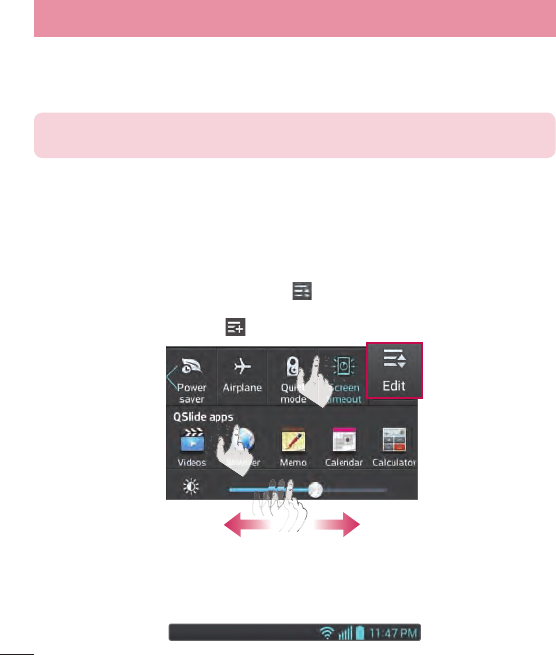
22
Your Home screen
Swipe down for notifications & settings
Swipe the Status Bar down to open the Notifications Panel. To close the
Notifications Panel, swipe the bar that is at the bottom of the screen upwards.
NOTE: Touch and hold an icon from the Quick Settings to view the function's
settings menu.
Quick Settings
Use Quick Settings to easily toggle function settings like Wi-Fi, manage
display brightness and more. The Quick Settings are located at the top of the
Notifications Panel.
To rearrange Quick Setting items on the Notification Panel
Open the Notifications Panel and touch . You can then view and rearrange the
desired items on the Quick Settings menu. To set more items to be displayed on
the Notifications panel, touch .
Indicator icons on the Status Bar
Indicator icons appear on the Status Bar at the top of the screen to report
missed calls, new messages, calendar events, device status and more.
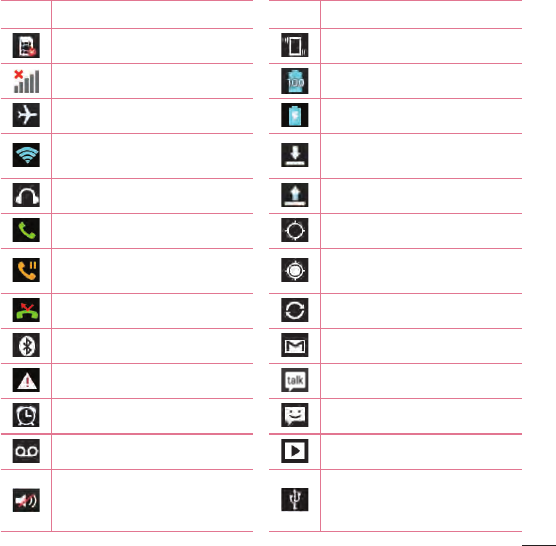
23
The icons displayed at the top of the screen provide information about the
status of the device. The icons listed in the table below are some of the most
common ones.
Icon Description Icon Description
No Micro SIM card Vibrate mode
No signal Battery fully charged
Airplane mode Battery is charging
Connected to a Wi-Fi
network Downloading data
Wired headset Uploading data
Call in progress GPS is acquiring
Call hold Receiving location data from
GPS
Missed call Data is syncing
Bluetooth is on New Gmail
System warning New Google Talk message
Alarm is set New message
New voicemail Song is playing
Ringer is silenced
Phone is connected to
PC via USB cable or USB
tethering is active
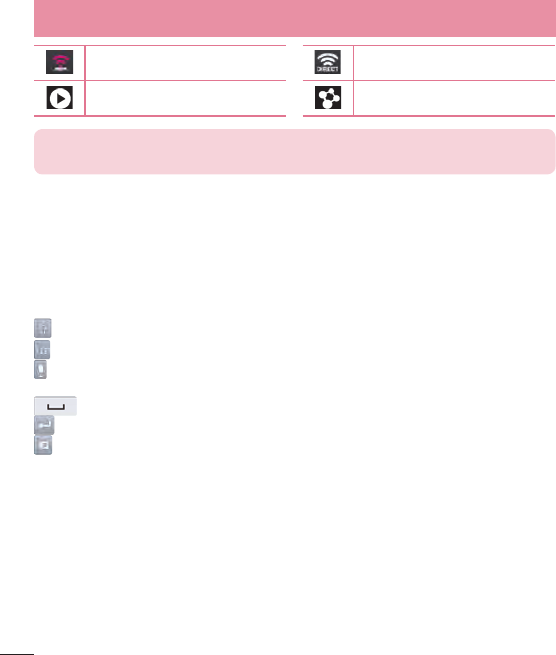
24
Your Home screen
Mobile HotSpot active Wi-Fi Direct activated
SmartShare music playing SmartShare on
NOTE: The icons location in the Status Bar may differ according to the function
or service.
On-screen keyboard
You can enter text using the on-screen keyboard. The on-screen keyboard
appears automatically on the screen when you need to enter text. To manually
display the keyboard, simply touch a text field where you want to enter text.
Using the keypad & entering text
Tap once to capitalize the next letter you type. Double-tap for all caps.
Tap to switch to the numbers and symbols keyboard.
Tap to use the voice input function. You can also touch and hold this icon to
select the handwriting and settings menu.
Tap to enter a space.
Tap to create a new line in the message field.
Tap to delete the previous character.
Entering accented letters
The on-screen keyboard allows you to enter special characters (e.g. "á").
For example, touch and hold the desired key (for example, the "a" key). After
the desired character appears, slide your your finger over it and lift it off to
enter it.

25
When you first turn on your phone, you have the opportunity to activate the
network, to sign into your Google Account and select how you want to use
certain Google services.
To set up your Google account:
• Sign into a Google Account from the prompted set-up screen.
OR
• From the Home screen, tap Apps > Apps tab > Settings > Accounts
& sync > ADD ACCOUNT > Google.
If you have a Google account, touch Existing, enter your email address and
password, then touch . Otherwise, touch New and enter the necessary
information to create a new Google Account.
Once you have set up your Google account on your phone, your phone
automatically synchronizes with your Google account on the Web.
Your contacts, Gmail messages, Calendar events and other information from
these applications and services on the Web are synchronized with your phone.
(This will depend on your synchronization settings.)
After signing in, you can use Gmail™ and take advantage of Google services
on your phone.
Google account setup

26
Wi-Fi
With Wi-Fi, you can use high-speed Internet access within the coverage of the
wireless access point (AP). Enjoy wireless Internet using Wi-Fi, without extra
charges.
Connecting to Wi-Fi networks
To use Wi-Fi on your phone, you need to access a wireless access point or
‘hotspot’. Some access points are open and you can simply connect to them.
Others are hidden or use security features; you must configure your phone to
be able to connect to them. Turn off Wi-Fi when you're not using it to extend
the life of your battery.
NOTE: If you are out of the Wi-Fi zone or have set Wi-Fi to OFF, additional
charges may be applied by your mobile operator for mobile data use.
Turning Wi-Fi on and connecting to a Wi-Fi network
1 From the Home screen, tap Apps > Apps tab > Settings > Wi-Fi
from the WIRELESS & NETWORKS.
2 Tap to turn it on and start scanning for available Wi-Fi networks.
3 Tap SEARCH to see a list of active and in-range Wi-Fi networks.
• Secured networks are indicated by a lock icon.
4 Touch a network to connect to it.
• If the network is secured, you are prompted to enter a password or other
credentials. (Ask your network administrator for details)
5 The Status Bar displays icons that indicate Wi-Fi status.
Bluetooth
You can use Bluetooth to send data by running a corresponding application,
but not from the Bluetooth menu as on most other mobile phones.
Connecting to Networks and Devices

27
NOTE:
• LG is not responsible for the loss, interception or misuse of data sent or
received via the Bluetooth wireless feature.
• Always ensure that you share and receive data with devices that are
trusted and properly secured. If there are obstacles between the devices,
the operating distance may be reduced.
• Some devices, especially those that are not tested or approved by
Bluetooth SIG, may be incompatible with your device.
Turning on Bluetooth and pairing up your phone with a Bluetooth
device
You must pair your device with another device before you connect to it.
1 From the Home screen, tap Apps > Apps tab > Settings > Bluetooth
from the WIRELESS & NETWORKS.
2 Tap to turn Bluetooth on. You will see the option to make your phone
visible and option to search devices. Then tap Search for devices to view
the devices in range.
3 Choose the device you want to pair with from the list.
Once the paring is successful, your device will connect to the device.
NOTE: Some devices, especially headsets or hands-free car kits, may have a
fixed Bluetooth PIN, such as 0000. If the other device has a PIN, you will be
asked to enter it.
Send data using the Bluetooth wireless feature
1 Open the item and tap .
OR
Touch and hold the item and select Share.
OR
Open the item and tap the Menu Key > Share.
2 Tap Bluetooth to share via Bluetooth.

28
Connecting to Networks and Devices
NOTE: The method for selecting an option may vary by data type.
3 Search for and pair with a Bluetooth-enabled device.
Receive data using the Bluetooth wireless feature
1 From the Home screen, tap Apps > Apps tab > Settings > Bluetooth.
2 Tap to turn Bluetooth on and mark the checkbox at the top of the
screen to visible on other devices.
NOTE: To select the length of time that your device will be visible, tap the Menu
Key > Visibility timeout.
3 Pair the devices and tap Pair when you receive a Bluetooth Authorization
Request to accept the fi le(s).
USB Tethering
You can use your phone to provide a data connection to a computer by
activating data tethering and connecting the phone and computer with a USB
cable.
To tether your phone with your computer using the USB
1 Connect your phone to your computer with a USB cable.
2 Tap Apps > Settings > Tethering & Networks > USB tethering. Tap
to turn it on.
NOTE:
• To use your phone’s tethering capability, you must have the Smartphone
Mobile Hotspot service added to your rate plan. Performance may vary
depending on the number of devices connected and other factors.
• You cannot access your phone’s microSD card on your computer when
using USB tethering.

29
Smartphone Mobile Hotspots
You can also use your phone to provide a mobile broadband connection for up
to 8 other devices. Create a hotspot and share your connection.
To create a portable hotspot, tap Apps > Settings > Tethering & Networks
> Mobile HotSpot. A checkmark indicates that the function is active. Then tap
Configure Mobile HotSpot and set a password upon first use.
NOTE: To use your phone’s Hotspot capability, you must have the Smartphone
Mobile Hotspot service added to your rate plan. In addition, your Smartphone
Mobile Hotspot service cannot be used at the same time as Wi-Fi. Please close
your WiFi connection prior to launching this service. Performance may vary
depending on the number of devices connected and other factors. If you do not
use a password, other unauthorized devices be able to use your Mobile Hotspot
connection.
Enabling Wi-Fi Direct to share through SmartShare
Wi-Fi Direct automatically scans nearby Wi-Fi Direct devices and the searched
devices are listed as they are found. This allows you to select a specific device
to share multimedia data with through SmartShare.
1 From the Home screen, tap Apps > Apps tab > Settings > Wi-Fi
from the WIRELESS & NETWORKS.
2 Tap to turn it on and touch the Menu Key > Wi-Fi Direct.
3 Select a device to connect with from the scanned device list.
CREATE GROUP – T
ouch to activate group owner mode, which enables the
legacy Wi-Fi devices to connect by scanning your phone.
NOTE: When your phone becomes a group owner it will consume more battery
power than when it is a client. The Wi-Fi Direct connection does not provide
Internet service. As a result, additional costs may be incurred when connecting
and using online services. Check data charges with your network provider.

30
Connecting to Networks and Devices
SmartShare
SmartShare uses DLNA (Digital Living Network Alliance) technology to share
digital content through a wireless network. Both devices must be DLNA
certified to support this feature.
To turn SmartShare on and allow sharing contents
1 From the Home screen, tap Apps > Apps tab > SmartShare .
2 Touch the Menu Key > Settings.
3 Touch Contents share to allow your device to be detected by other devices.
• Select Sharing requests if you would like to select how to accept sharing
requests from other devices. Choose from Always accept, Always ask, and
Always deny.
• Touch Receive files if you would like to allow the other devices to upload
media files to my phone.
NOTE: Make sure that the microSD card is correctly mounted and the Receive
files option in the Settings menu is checked.
4 Touch Shared contents to checkmark the types of content you would like to
share.
Choose from Photos, Videos, and Music.
5 SmartShare is now activated and ready to share contents.
To control your renderer devices
Let your renderer device (e.g., TV) play multimedia contents from your remote
content library (e.g., PC).
NOTE: Make sure that the DLNA functionality of your devices is properly
configured (e.g., for TV and PC).
1 From the Home screen, tap Apps > Apps tab > SmartShare .
2 Touch the Player and select the device from the renderer device list.
3 Touch the Library and select the device for the remote content library.

31
4 You can browse the content library.
5 Touch and hold a content thumbnail and touch Play or touch the Menu
Key > Play.
To share contents from your phone to your renderer device (e.g.
TV)
NOTE: Make sure that your renderer device is properly configured.
1 While watching your pictures or videos using the Gallery application, touch
/ / at the top of the screen.
: Need to be connected to a network
: Select the device in the network
: Currently, the content is being shared through SmartShare.
NOTE: Follow the same steps to use the Music, Videos and Polaris Office 4
apps to share contents.
2 Select the device from renderer lists to play the fi les.
NOTICE: Check that your device is connected with your home network using
Wi-Fi connection to use this application.
Some DLNA enabled devices (e.g. TV) support only the DMP feature of DLNA
and will not appear in the renderer device list.
Your device might not be able to play some contents.
To download contents from the remote content library
1 From the Home screen, tap Apps > Apps tab > SmartShare .
2 Touch the Library and select the device of the remote content library.
3 You can browse the content library.
4 Touch and hold a content thumbnail and then touch Download or touch
the Menu Key > Download.

32
Connecting to Networks and Devices
NOTICE: Some contents are not supported.
To upload contents to the remote content library
1 From the Home screen, tap Apps > Apps tab > SmartShare .
2 Touch the Library and select My phone.
3 You can browse the local content library to fi nd the content(s) you want.
4 Touch and hold a content thumbnail and then touch Upload or touch the
Menu Key > Upload.
5 Select the device of the remote content library to be uploaded.
NOTICE: Some DLNA enabled devices do not support the DMS upload
functionality and will not upload files. Some contents are not supported.
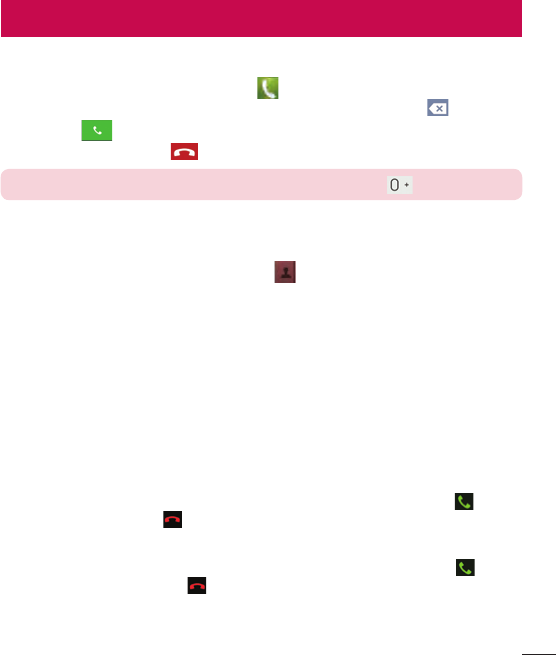
33
Making a call
1 From the Home screen, tap Phone to open the keypad.
2 Enter the number on the keypad. To delete a digit, tap Clear .
3 Tap Call to make a call.
4 To end a call, tap End .
TIP! To enter “+” to make international calls, touch and hold .
Calling your contacts
1 From the Home screen, tap Contacts to open your contacts.
2 Scroll through the contact list or tap the Search contacts box and enter
the fi rst letter(s) of the contact you want to call. You can also tap a letter
along the right side of the screen to access names starting with the
chosen letter.
3 In the list that is displayed, tap the contact you want to call.
4 In the Contact Info screen, tap the phone number you wish to call.
Answering and rejecting a call
Locked screen
To answer an incoming call when the screen is locked, swipe Answer in any
direction. Swipe Decline in any direction to decline an incoming call.
Unlocked screen
To answer an incoming call when the screen is unlocked, tap Answer . To
decline the call, tap Decline .
Calls
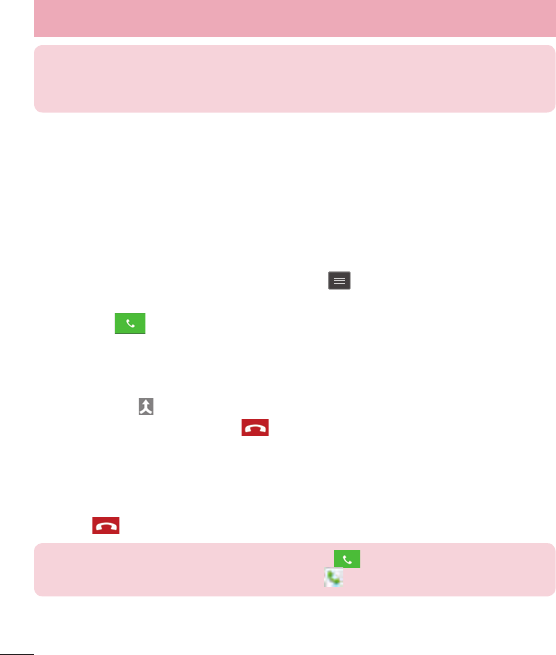
34
Calls
TIP! Decline with message
You can send a message quickly using this function. This is useful if you need to
reject a call with message during a meeting.
Adjusting the in-call volume
To adjust the in-call volume during a call, use the Volume Keys on the left side
of the phone.
Making a second call
1 During your initial call, tap the Menu Key and select Add call.
2 Dial the number or search your contacts.
3 Tap Call to connect the call.
4 Both calls will be displayed on the call screen. Your initial call will be put on
hold.
5 Tap the call entry on the screen to toggle between active calls or tap
Merge calls to merge the calls.
6 To end active calls, tap End . If there is no active call, it will end the call
on Hold.
Ending a Call
Tap End to end a call.
NOTE: To redial recent numbers, touch Redial at the end of the call or find
the number within the Call logs and tap Call to the right of the entry.
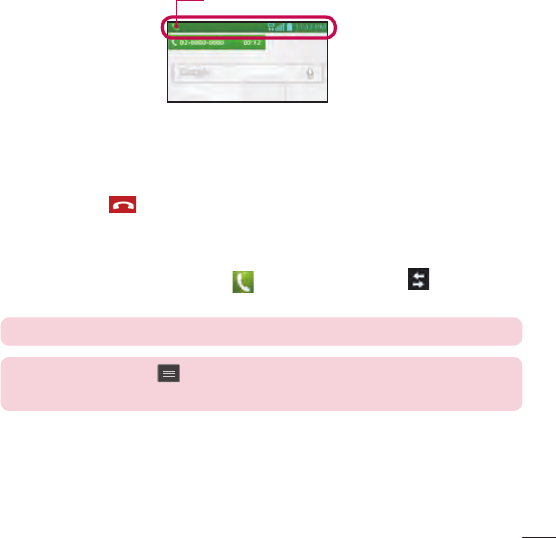
35
If you exit the current call screen and return to the Home screen, you will be
notified that you are still on an active call by the green phone icon within the
Status Bar.
Active Call Notification
Ending a Call from the Status Bar
1 Touch and drag the Status Bar down to open the Notifi cations Panel.
2 Tap End call to end the currently active call.
Viewing your call logs
From the Home screen, tap Phone , then tap the Call logs tab.
View a complete list of all dialed, received, and missed voice calls.
TIP! Tap any single call log entry to view the date, time, and duration of the call.
TIP! Tap the Menu Key , then tap Clear to delete entries individually or Clear
all to delete all.

36
Calls
Call settings
You can configure phone call settings, such as call forwarding, and other
special features offered by T-Mobile.
1 From the Home screen, tap Apps > Settings .
2 Tap Call and set any desired options.

37
You can add contacts on your phone and synchronize them with the contacts
in your Google Account or other accounts that support syncing contacts.
Searching for a contact
1 From the Home screen, tap Contacts to open your contacts.
2 Tap the Search contacts box and enter the contact name using the keypad.
You can also tap a letter along the right side of the screen to access names
starting with the chosen letter.
Adding a new contact
1 From the Home screen, tap Phone and enter the new contact’s number.
2 Tap the Menu Key > Add to Contacts > Create new contact. Select the
desired account (if applicable).
3 If you want to add a picture to the new contact, tap . Choose from Tak e
photo to take a picture using the camera or Select from Gallery. Then
browse for an image and select it.
4 Tap to enter more specifi c name information.
5 Enter the details about your contact.
6 Tap Save to save the contact entry.
Favorite Contacts
You can classify frequently called contacts as favorites.
To add a contact to your favorites
1 From the Home screen, tap Contacts to open your contacts.
2 Tap a contact to view its details.
3 Tap the star to the right of the contact’s name. The star turns gold and the
contact is added to your favorites.
Contacts

38
Contacts
To remove a contact from your favorites list
1 From the Home screen, tap Contacts to open your contacts.
2 Tap the Favorites tab to view your favorite contacts.
3 Tap a contact to view its details.
4 Tap the gold star to the right of the contact’s name. The star turns grey
and the contact is removed from your favorites.
Creating a group
1 From the Home screen, tap Contacts to open your contacts.
2 Touch the Groups tab, then touch the Menu Key and select New group.
3 Enter a name for the new group. You can also set a ringtone for the group.
4 Touch Save to save the group.
NOTE: If you delete a group, the contacts assigned to that group will not be lost.
They will remain in your contacts.